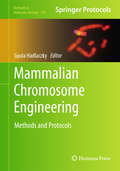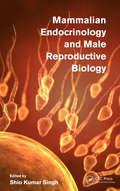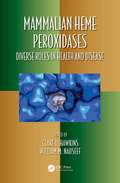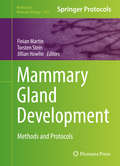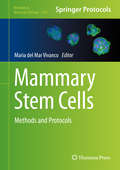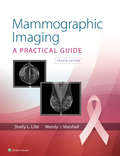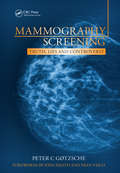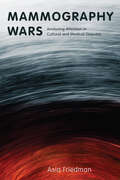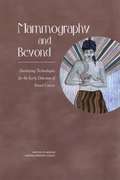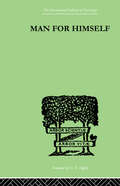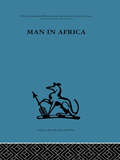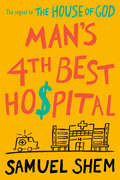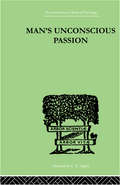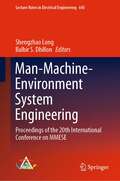- Table View
- List View
Mammalian Chromosome Engineering
by Gyula HadlaczkyThe rapid progression of genetics and molecular biology has turned chromosomal engineering from science fiction to reality, with the successful production of transgenic animals with engineered chromosomes and chromosomes developed for pharmaceutical protein production which are now ready for the medical industry. Mammalian Chromosome Engineering: Methods and Protocols provides the reader with up-to date information on this rapidly evolving field and strives to take the reader into the exciting realm of chromosomal engineering from the basic principles to the practical applications of these new technologies. The five overview and ten protocol chapters cover the engineering of chromosomes with extrachromosomal vectors and transposon systems, the manipulation of naturally occurred minichromosomes, the generation and engineering of synthetic artificial chromosomes, and the induced de novo platform artificial chromosome system. Written in the highly successful Methods in Molecular BiologyTM series format, protocols chapters contain brief introductions to their respective topics, lists of the necessary materials and reagents, step-by-step, readily reproducible laboratory protocols, and tips on troubleshooting and avoiding known pitfalls. Authoritative and cutting-edge, Mammalian Chromosome Engineering: Methods and Protocols serves as a bench-side resource for current protocols and aims to help scientists to explore the many prospects for future research and vital applications.
Mammalian Egg Transfer
by Lewis AdamsEgg transfer was first performed in 1890, but for half a century it received scant attention. However, since 1950 the technique has become increasingly widely used - in the laboratory for fundamental studies and more recently in practice, both veterinary and medical, to boost reproductive potential of genetically superior cattle and to overcome sterility due to impaired rubal function in women. As a result, a considerable body of literature has accumulated, totaling well in excess of a thousand references. But till now there has not been a single comprehensive text devoted solely to this subject. The present work was designed to meet that need at a time when the field is fast expanding with new techniques and approaches constantly being evolved. One need only cite the tremendous rate of progress in human egg transfer in the last three years. The work embraces laboratory and farm animals and primates, including man, altogether representing a total of 16 species.
Mammalian Endocrinology and Male Reproductive Biology
by Shio Kumar SinghMammalian Endocrinology and Male Reproductive Biology provides comprehensive and current coverage of the area of endocrinology and male reproductive biology, covering not just humans, but mammals in general. Written by international experts in their respective fields, this multi-author book also covers the latest developments in genomics of androge
Mammalian Heme Peroxidases: Diverse Roles in Health and Disease (Oxidative Stress and Disease #47)
by Clare L. HawkinsMammalian heme peroxidase enzymes play a critical role in innate immune responses and disease prevention. The formation of potent chemical oxidants is essential to this protective physiologic activity in immunity. Although highly beneficial in the context of immune defense, it is now well established that peroxidases and their overproduction of oxidants contribute to the initiation and persistence of many chronic inflammatory conditions in the cardiovascular, neurologic, respiratory, renal, and gastrointestinal systems. Peroxidasins, a protein family related to heme peroxidases, play a novel role in tissue biogenesis and matrix assembly, which are also attracting attention in different pathological contexts. Given the diverse roles of mammalian heme peroxidases and the breadth and incidence of pathologies associated with these enzymes, there has been significant interest in modulating peroxidase activity as a therapeutic strategy. This book highlights recent developments in our understanding of the chemistry, biochemistry and biological roles of mammalian peroxidases and their associated oxidants, their involvement in both innate immunity and chronic inflammatory disease in a variety of end organs, and potential therapeutic approaches to modulate and prevent damaging reactions. Key Features Structure and biosynthesis of mammalian peroxidases Reactivity of hypohalous acids with biological substrates Peroxidases in innate immunity Peroxidases in human pathology Modulation of peroxidase-induced biological damage
Mammalian Neuroendocrinology
by Paul V. MalvenMammalian Neuroendocrinology presents a concise examination of how the nervous and endocrine systems interact to regulate physiological processes. Selected experimental results are presented to illustrate the current understanding of neuroendocrine processes. Neural influences and endocrine feedback mechanisms related to the secretion of adenohypophysial hormones are summarized for each hormone. The book's concise nature and readable style are highly suited for use as a graduate textbook.There are also chapters devoted to each of the following topics: neurohypophysis, pineal gland, adrenal medulla, hormones and behavior, and neuroendocrine immunology. Comparisons are made among species of mammals, including laboratory rodents, domesticated ungulates, and primates. Agricultural and/or clinical aspects relevant to these topics are covered when appropriate. Mammalian Neuroendocrinology is excellent for students and professionals in neuroendocrinology, neuroscience, endocrinology, reproduction studies, and animal sciences.
Mammalian Sexuality: The Act of Mating and the Evolution of Reproduction
by Alan F. DixsonThere are more than 6000 species belonging to twenty-seven orders in the Class Mammalia. Comparative studies of this diverse and magnificent array of extant species provide valuable opportunities to formulate and test hypotheses concerning the evolution of reproduction. This is the first book to explore, in depth and breadth, the complex interrelationships that exist between patterns of mating behaviour and the evolution of mammalian reproductive anatomy and physiology. It focuses upon the role that copulatory and post-copulatory sexual selection have played during the evolution of the monotremes, marsupials and placental mammals, and examines the effects of sperm competition and cryptic female choice upon coevolution of the genitalia in the two sexes. In addition, due weight is also given to discussions of the modes of life of mammals, and to the roles played by natural selection and phylogeny in determining their reproductive traits.
Mammalian Sterols: Novel Biological Roles of Cholesterol Synthesis Intermediates, Oxysterols and Bile Acids
by Damjana Rozman Rolf GebhardtThis book provides a comprehensive description of sterols and their novel biological roles in mammalian signaling, the book covers their biosynthesis and structure, describes sterol receptor -mediated actions, their tissue distribution and their role in disease. It offers insight into new research findings, focusing specifically on novel discoveries in bile acid and oxysterol signaling, including the lanosterol-to-cholesterol intermediates. Special attention is paid on the sex distribution of these sterols (male or female) and their sexually dimorphic roles in mammalian species, such as human, rat and mouse. Since sterols and drugs (xenobiotics) use many identical receptor-mediated signaling pathways, the book will be interesting for researchers working on the cross-road of endogenous and xenobiotic metabolism, it is intended for advanced students and scientists in molecular biology and biochemistry as well as for medical doctors in hepatology.
Mammary Gland Development
by Finian Martin Torsten Stein Jillian HowlinThis volume provides key molecular biological protocols and experimental strategies currently employed to study the various stages of mammary gland development. Chapters are divided into four parts covering genetically modified mouse models that exhibit prenatal and pubertal mammary gland phenotypes, 2D and 3D-model culture systems, methodologies for mammary stem cell isolation, and translational applications that provide a bridge between experimental studies of mammary gland development and the study of human breast cancer. Written in the highly successful Methods in Molecular Biology series format, chapters include introductions to their respective topics, lists of the necessary materials and reagents, step-by-step, readily reproducible laboratory protocols, and tips on troubleshooting and avoiding known pitfalls. Authoritative and cutting-edge, Mammary Gland Development: Methods and Protocols will be useful for researchers whose primary interest is in mammary gland development; developmental biologists, epithelial cell biologists, and those with an interest in molecular mechanisms underlying breast cancer.
Mammary Stem Cells
by Maria del Mar VivancoThe identification of normal and breast cancer stem cells has offered a new vision of this heterogeneous disease and new hopes for its prognosis and treatment. This volume provides an overview of recent developments in mammary stem cell research and discusses the many varieties of approaches used by researchers to investigate the properties and functions of mammary stem cells. The beginning chapters provide readers with an introduction to mammary stem cells, and the processes used to characterize stem cells and isolate them via fluorescent activated cell sorting. The next few chapters discuss DNA and mRNA sequencing, proteomic techniques to help profile cells, lentiviral cell transduction for gene expression, and in vivo lineage tracing. The final few chapters are dedicated to following stem cells from their initial niche to the new microenvironment at their metastasis site, and to studying these cells using physical and mathematical approaches. Written in the highly successful Methods in Molecular Biology series format, the chapters include the kind of detailed description and implementation advice that is crucial for getting optimal results in the laboratory. Authoritative and cutting-edge, Mammary Stem Cells: Methods and Protocols aims to help members of the scientific community explore the behavior of stem cells and how to work with them in order to guide the design of new and complimentary strategies to be applied in the clinic with the ultimate end goal of fighting breast cancer.
Mammary Stem Cells: Methods and Protocols (Methods in Molecular Biology #2471)
by Maria Dm. VivancoThis second edition provides an overview of recent developments and approaches used by researchers to investigate the properties and functions of mammary epithelial and stem cells, which will contribute to understand the heterogeneity of the mammary gland and of breast cancer. Chapters detail processes used to characterize stem cells, single cell RNA sequencing, computational methods, sophisticated imaging techniques, and a variety of model systems, among others. Written in the highly successful Methods in Molecular Biology series format, chapters include introductions to their respective topics, lists of the necessary materials and reagents, step-by-step, readily reproducible laboratory protocols, and tips on troubleshooting and avoiding known pitfalls. Authoritative and cutting-edge, Mammary Stem Cells: Methods and Protocols, Second Edition aims to make available protocols used to navigate the intricate behavior of mammary stem cells and to gain further knowledge to take us closer to the design of innovative strategies to prevent and treat breast cancer.
Mammographic Imaging: A Practical Guide
by Shelly Lille Wendy MarshallPublisher's Note: Products purchased from 3rd Party sellers are not guaranteed by the Publisher for quality, authenticity, or access to any online entitlements included with the product. The 4th Edition of Mammographic Imaging: A Practical Guide remains the most up-to-date and comprehensive book in the field. A perfect all-in-one solution for coursework, board prep, and clinical practice, this bestseller reflects the latest ARRT educational and certification exam requirements, as well as the ASRT recommended curriculum. Technologists seeking to stay current in the profession and students preparing to enter the field will appreciate the 227 new photos, the wide range of case studies, and the interactive online exam simulator with ARRT registry-style questions.
Mammography Screening: Truth, Lies and Controversy
by Peter Gotzsche'This book gives plenty of examples of ad hominem attacks, intimidation, slander, threats of litigation, deception, dishonesty, lies and other violations of good scientific practice. For some years I kept a folder labeled Dishonesty in breast cancer screening on top of my filing cabinet, storing articles and letters to the editor that contained statements I knew were dishonest. Eventually I gave up on the idea of writing a paper about this collection, as the number of examples quickly exceeded what could be contained in a single article.' From the Introduction The most effective way to decrease women's risk of becoming a breast cancer patient is to avoid attending screening. Mammography screening is one of the greatest controversies in healthcare, and the extent to which some scientists have sacrificed sound scientific principles in order to arrive at politically acceptable results in their research is extraordinary. In contrast, neutral observers increasingly find that the benefit has been much oversold and that the harms are much greater than previously believed. This groundbreaking book takes an evidence-based, critical look at the scientific disputes and the information provided to women by governments and cancer charities. It also explains why mammography screening is unlikely to be effective today. All health professionals and members of the public will find these revelations disturbingly illuminating. It will radically transform the way healthcare policy makers view mammography screening in the future. 'If Peter Gotzsche did not exist, there would be a need to invent him ...It may still take time for the limitations and harms of screening to be properly acknowledged and for women to be enabled to make adequately informed decisions. When this happens, it will be almost entirely due to the intellectual rigour and determination of Peter Gotzsche.' From the Foreword by Iona Heath, President, RCGP 'If you care about breast cancer, and we all should, you must read this book. Breast cancer is complex and we cannot afford to rely on the popular media, or on information from marketing campaigns from those who are invested in screening. We need to question and to understand. The story that Peter tells matters very much.' From the Foreword by Fran Visco, President, National Breast Cancer Coalition
Mammography Wars: Analyzing Attention in Cultural and Medical Disputes (Critical Issues in Health and Medicine)
by Asia FriedmanMammography is a routine health screening performed forty million times each year in the United States, yet it remains one of the most deeply contested topics in medicine, with national health care organizations supporting conflicting guidelines. In Mammography Wars, sociologist Asia Friedman examines cultural and medical disagreements over mammography. At issue is whether to screen women under age fifty, which is rooted in deeper questions about early detection and the assumed linear and progressive development of breast cancer. Based on interviews with doctors and scientists, interviews with women ages 40 to 50, and newspaper coverage of mammography, Friedman uses the sociology of attention to map the cognitive structure of the “mammography wars,” offering insights into the entrenched nature of debates over mammography that often get missed when applying a medical lens. Friedman’s analysis also suggests the sociology of attention’s unique potential for analyzing cultural conflicts beyond mammography, and even beyond medicine.
Mammography and Beyond: Developing Technologies for the Early Detection of Breast Cancer
by Institute of MedicineEach year more than 180,000 new cases of breast cancer are diagnosed in women in the U.S. If cancer is detected when small and local, treatment options are less dangerous, intrusive, and costly-and more likely to lead to a cure.Yet those simple facts belie the complexity of developing and disseminating acceptable techniques for breast cancer diagnosis. Even the most exciting new technologies remain clouded with uncertainty. Mammography and Beyond provides a comprehensive and up-to-date perspective on the state of breast cancer screening and diagnosis and recommends steps for developing the most reliable breast cancer detection methods possible.This book reviews the dramatic expansion of breast cancer awareness and screening, examining the capabilities and limitations of current and emerging technologies for breast cancer detection and their effectiveness at actually reducing deaths. The committee discusses issues including national policy toward breast cancer detection, roles of public and private agencies, problems in determining the success of a technique, availability of detection methods to specific populations of women, women's experience during the detection process, cost-benefit analyses, and more.Examining current practices and specifying research and other needs, Mammography and Beyond will be an indispensable resource to policy makers, public health officials, medical practitioners, researchers, women's health advocates, and concerned women and their families.
Mamá come sano: Alimentación saludable en el embarazo y la lactancia
by Julio BasultoEl embarazo y la lactancia son etapas maravillosas, pero repletas de dudas acerca de la dieta. ¿Influye la alimentación en mi fertilidad o en la de mi pareja? ¿Conviene recurrir a vitaminas, minerales, plantas medicinales, complementos alimenticios o fármacos? ¿Cuántas calorías debo tomar? ¿Cuánta agua tengo que beber? ¿Son un síntoma de peligro las náuseas u otras molestias típicas del embarazo? ¿Qué es ganar mucho (o poco) peso en el embarazo? ¿Cómo recupero la figura tras el parto? ¿Puedo ser vegetariana? ¿Es acaso una cuestión inextricable la alimentación en la lactancia? ¿Qué es (de verdad) una dieta sana?Julio Basulto aborda estas y muchas otras inquietudes, para ayudar al lector a formarse un criterio para elegir y decidir. Este libro no propone una dieta prodigiosa gracias a la cual tendremos un bebé extraordinario, recuperaremos el tipo rápidamente tras un parto fácil e indoloro, y produciremos abundante y nutritiva leche materna. Por el contrario, nos hará cuestionar muchos de nuestros hábitos alimenticios, algo absolutamente necesario no solo para la salud maternoinfantil, sino también para la de toda la familia.
Man & His Fellowmen: Modern Chapters on Social Psychology
by Lowy, SamuelFirst published in 1999. Routledge is an imprint of Taylor & Francis, an informa company.
Man And Nature In The Renaissance (Cambridge Studies In The History Of Science Series)
by George Basalla Allen George Debus Owen HannawayMan and Nature in the Renaissance offers an introduction to science and medicine during the earlier phases of the scientific revolution, from the mid-fifteenth century to the mid-seventeenth century. Renaissance science has frequently been approached in terms of the progress of the exact sciences of mathematics and astronomy, to the neglect of the broader intellectual context of the period. Conversely, those authors who have emphasized the latter frequently play down the importance of the technical scientific developments. In this book, Professor Debus amalgamates these approaches: The exact sciences of the period are discussed in detail, but reference is constantly made to religious and philosophical concepts that play little part in the science of our own time. Thus, the renewed interest in mystical texts and the subsequent impact of alchemy, astrology, and natural magic on the development of modern science and medicine are central to the account. Major themes that are followed throughout the book include the effects of humanism, the search for a new method of science, and the dialogue between proponents of the mystical-occult world view and the mathematical-observational approach to nature.
Man In His Relationships
by Westmann, HFirst Published in 1999. Routledge is an imprint of Taylor & Francis, an informa company.
Man In The Picture: The Family Hunt For An Unkown Man
by Magdel RoetsAn elderly woman dies with the picture of a man in her hand. No one knows who the man is and the hunt for the truth begins.
Man for Himself: An Inquiry into the Psychology of Ethics (Routledge Classics Ser.)
by Fromm, ErichFirst published in 1999. Routledge is an imprint of Taylor & Francis, an informa company.
Man in Africa
by Mary Douglas Phyllis M KaberryTavistock Press was established as a co-operative venture between the Tavistock Institute and Routledge & Kegan Paul (RKP) in the 1950s to produce a series of major contributions across the social sciences. This volume is part of a 2001 reissue of a selection of those important works which have since gone out of print, or are difficult to locate. Published by Routledge, 112 volumes in total are being brought together under the name The International Behavioural and Social Sciences Library: Classics from the Tavistock Press. Reproduced here in facsimile, this volume was originally published in 1969 and is available individually. The collection is also available in a number of themed mini-sets of between 5 and 13 volumes, or as a complete collection.
Man's 4th Best Hospital
by Samuel ShemThe sequel to the bestselling and highly acclaimed The House of GodYears after the events of The House of God, the Fat Man has been given leadership over a new Future of Medicine Clinic at what is now only Man's 4th Best Hospital, and has persuaded Dr. Roy Basch and some of his intern cohorts to join him to teach a new generation of interns and residents. In a medical landscape dominated by computer screens and corrupted by money, they have one goal: to make medicine humane again. What follows is a mesmerizing, heartbreaking, and hilarious exploration of how the health-care industry, and especially doctors, have evolved over the past thirty years.
Man's Unconscious Passion
by Lay, WilfridFirst published in 1999. Routledge is an imprint of Taylor & Francis, an informa company.
Man, Interrupted: Welcome to the Bizarre World of OCD, Where Once More is Never Enough
by James BaileyJames Bailey's form of obsessive-compulsive disorder (OCD) was as bizarre as it was unbearable. He was obsessed by a fear of drugs and their effects, believing himself to be in constant danger of becoming insanely high through people spiking his food, or even by just touching a photograph of a marijuana leaf.The treatment programme he went through at a specialist American clinic was challenging, to say the least. He was asked to shake hands and mingle with the local junkies, fighting his anxieties and the urge to go and wash for as long as possible in order to 'expose' himself to his fears.Man, Interrupted gives us a glimpse into the tortured world of a man suffering from what is an increasingly common disorder. But far from being a doom-laden account of mental illness, the result is uniquely revealing, hilariously entertaining and wonderfully rewarding.
Man-Machine-Environment System Engineering: Proceedings of the 20th International Conference on MMESE (Lecture Notes in Electrical Engineering #645)
by Balbir S. Dhillon Shengzhao LongThis book presents selected papers introducing readers to the key research topics and latest development trends in the theory and application of MMESE. The advanced integrated research topic man-machine-environment system engineering (MMESE) was first established in China by Professor Shengzhao Long in 1981, with direct support from one of the greatest modern Chinese scientists, Xuesen Qian. In a letter to Shengzhao Long from October 22nd, 1993, Xuesen Qian wrote: “You have created a very important modern science and technology in China!”MMESE primarily focuses on the relationship between man, machine and environment, studying the optimum combination of man-machine-environment systems, where “man” refers to people in the workplace (e.g., operators, decision-makers), “machine” is the general name for any object controlled by man (including tools, machinery, computers, systems and technologies), and “environment” describes the specific working conditions under which man and machine interact (e.g., temperature, noise, vibration and hazardous gases). The three goals of optimizing such systems are ensuring safety, efficiency and economy.Presenting interdisciplinary studies on the concepts and methods in physiology, psychology, system engineering, computer science, environmental science, management, education and other related disciplines, this book is a valuable resource for all researchers and professionals whose work involves MMESE subjects.
